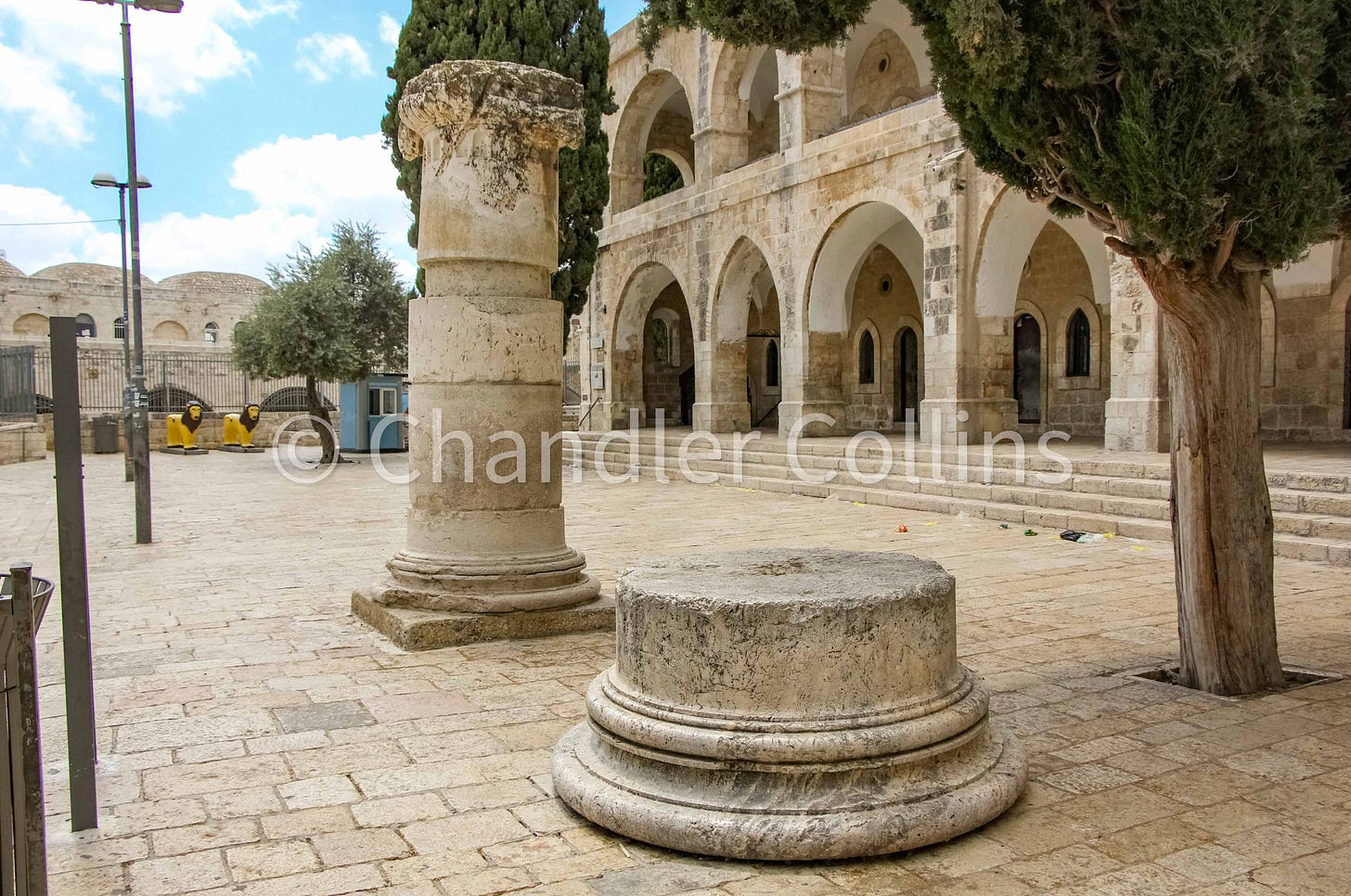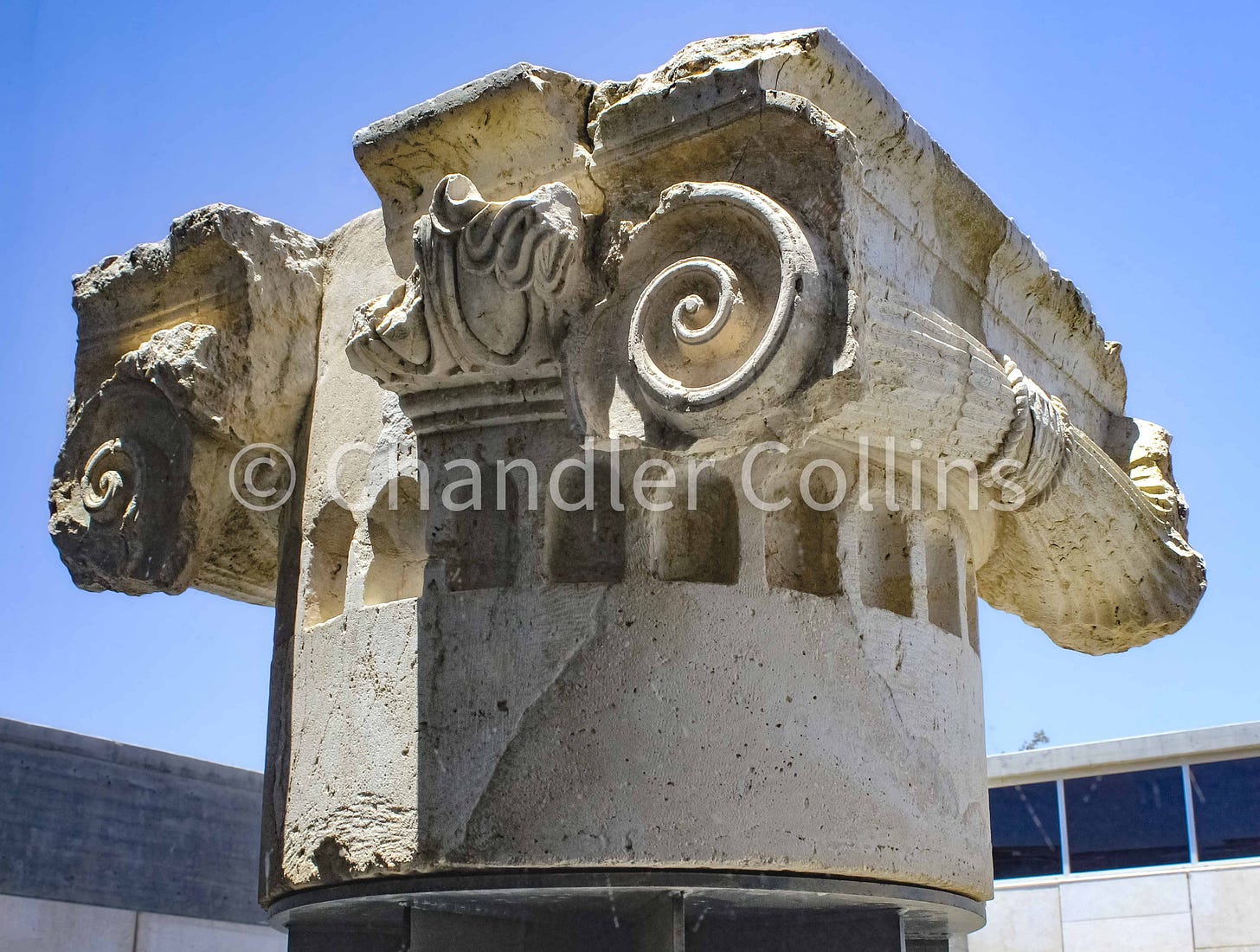Some Unexpected Architectural Fragments from the Jewish Quarter
Decorative pieces of Greek architecture uncovered in Nahman Avigad's excavations belonged to a monumental and ornate and building whose identity remains unknown.
PSA: I’d like to devote a forthcoming newsletter to reader questions. You are welcome to submit them here, and if relevant, I will attempt to address them as best I can in an upcoming post. Preference will go to paid subscribers and monthly patrons.
If you find this newsletter valuable, consider upgrading to a paid subscription
There is a whole lot about Jerusalem’s history and archaeology that remains unexplained. Recent weeks have seen a flurry of news reports about some fascinating and “mysterious” rock-cut channels from the Iron Age found in the Givati Parking Lot Excavations, for instance. This discovery joins a vast archive of obscure material remains unearthed in Jerusalem. Today’s post taps into this archive by exploring pieces of an unknown monumental building that were recovered in the 1970s.

An unexpected surprise
During the reconstruction of Jerusalem’s Jewish Quarter after 1967, concurrent with Nahman Avigad’s salvage excavations there, some unexpected large fragments emerged from the dirt. Among them are column drums, bases, and capitals in whole or part. Today these remains are displayed in spaces across Jerusalem, and perhaps you have stumbled upon the large pieces which are displayed in the Batei Maḥseh Square (pictured above).
While their concrete identity is understood, the building they were associated with in antiquity is unknown. None of these fragments were found in their original locations (in situ) or associated with a nearby structure that could be archaeologically identified. Some were excavated carefully but found reused in later contexts. Others were unearthed accidentally by large machinery. Let’s explore the scholarly discussion around these remains since they have come to light.
First interpretations
Based on the size of these fragments, all scholars agree that they were intended for a monumental building. A look at their find spots indicates they came from the same general area, the lower eastern plateau of the Western Hill (today’s Jewish Quarter). Some scholars have assumed there were two groups of architectural fragments: one group found slightly north that can be dated earlier (ca. 1st century BCE) and another group found further to the south that dates later (ca. 1st century CE).1 Although not known with certainty, this division would open the possibility that the collective remains may have belonged to two or more different buildings from slightly different time periods. Broadly speaking, scholarship has been divided over whether these fragments were included in a building that was constructed nearby the area where they were uncovered or if they were brought there from buildings constructed elsewhere and later destroyed.

Very interestingly, the northern areas of Avigad’s excavations sit near the presumed location of the Hasmonean palace. Josephus, our only historical witness to the palace’s location, writes that it sat above the bridge that connected the Western Hill with the Temple Mount (running beneath today’s Bab as-Silsileh Street). This building was later used by King Herod Agrippa I and, according to Josephus, allowed him a comfortable view down to the Temple Mount.2
Avigad mentioned the possibility of uncovering remains from the Hasmonean palace in his first preliminary excavation report:
“The significance of such excavations in this area is self-evident. The Jewish Quarter, situated on the Western Hill of Jerusalem overlooking the Temple Mount, covers the former north-eastern part of the Upper City of Jerusalem in the Second Temple period. It is believed to be the site of an important residential quarter, of such important public buildings as the Hasmonean palace and, perhaps, also the Akra fortress.” (1970:2)
Could some of these fragments, then, be related to this important building? Despite the temptation to assume so, Avigad thought the initial few pieces he uncovered were more likely destined for a temple rather than a palace. Michael Avi-Yonah, another senior scholar active in Jerusalem at the time, argued that these fragments were indeed intended for a temple of the Hellenistic Period dedicated to Olympian Zeus. He thought this building project was initiated by Antiochus IV Epiphanes but never finished (1971:169). Most scholars (including Avigad) have doubted this idea, but it has recently been readopted as a possibility, at least that could explain some of the architectural fragments (Reich in Geva 2003:273). It was also suggested that these remains may have come from other Hellenistic buildings in Jerusalem, such as the gymnasium known from I Maccabees and Josephus (B. Mazar and H. Eshel 1998:268).

Traveling fragments
Other scholars think these decorative architectural fragments did not originate in a building that sat on the plateau of the Jewish Quarter but arrived there from elsewhere. Avigad entertained the possibility that some may have been brought from the Temple Mount after its destruction in 70 CE (1980:162; 165). More recently, others have supported this idea (Reich 2017:90). Mitigating against this is the city’s geography, as workers would have had to haul these heavy pieces upslope from the Central Valley either for an unclear purpose or simply to be reused as building stone.3

Yet another proposal ascribes the monumental remains to Herod’s palace which was built at the height of the Western Hill. Perhaps they rolled down after the building’s destruction during the Jewish Revolt. Orit Peleg-Barkat has made this compelling suggestion in several publications4 and points out one very interesting potential implication:
“The group of monumental Ionic columns…found on the Southwestern Hill…if indeed [they] belong to Herod’s palace (currently no better candidate exists), implies that the palace spread considerably east." (Peleg-Barkat 2019:68)
If correct, this would have an impact on how we understand the topography of the Western Hill in the Roman Period. The idea that some of these pieces came from Herod’s palace seems to provide a simple and plausible explanation.

Embracing the unknown
A final and obvious possible explanation has been mentioned by nearly all scholars writing about this issue: these fragments may have simply been created for an unknown building (or buildings) whose exact location(s) and purpose(s) is unclear. Perhaps further excavations will provide us with better direction, and perhaps they won’t. In some ways, our understanding seems not to have moved far beyond Avigad’s summary statement about this issue in his book Discovering Jerusalem:
"This complex and fascinating problem has so far defied solution." (1980:62)
In the meantime, we can enjoy a view of the fragments at their various locations of display:
Wohl Museum: two volute fragments of Ionic capitals (pending the museum renovation and reopening)
Israel Museum: a large reconstructed Ionic capital and Corinthian capital with several column drums and base
Batei Maḥseh Square in the Jewish Quarter: large pillar base and partially reconstructed pillar with Ionic capital and base
Tourism office in Hurva Square: one column drum
Do you know where additional architectural fragments found in the Jewish Quarter are displayed? Leave a comment below.
This is Ronny Reich’s argument in the second volume of the final report from Avigad’s excavations (in Geva 2003:273).
Although it is not indicated in the text, the majority of scholars assume that Herod Antipas was residing in this building at Passover during his brief appearance in Luke’s recounting of Jesus’ trials (Lk. 23:6-16).
Gabriel Barkay has also suggested this in an archaeology of Jerusalem course at Jerusalem University College, although I do not know whether he has published the argument anywhere.
Enjoy this post?
Show your appreciation by leaving a tip as low as the price of a cup of coffee
Follow Approaching Jerusalem
View previous editions of this newsletter or follow us on social media for archaeological stories, upcoming lectures, and other Jerusalem-related news, resources, and analysis.

